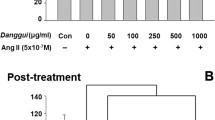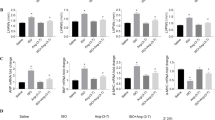Summary
Pathological cardiac hypertrophy induced by angiotensin II (AngII) can subsequently give rise to heart failure, a leading cause of mortality. Nardosinone is a pharmacologically active compound extracted from the roots of Nardostachys chinensis, a well-known traditional Chinese medicine. In order to investigate the effects of nardosinone on AngII-induced cardiac cell hypertrophy and the related mechanisms, the myoblast cell line H9c2, derived from embryonic rat heart, was treated with nardosinone (25, 50, 100, and 200 μmol/L) or AngII (1 μmol/L). Then cell surface area and mRNA expression of classical markers of hypertrophy were detected. The related protein levels in PI3K/Akt/mTOR and MEK/ERK signaling pathways were examined by Western blotting. It was found that pretreatment with nardosinone could significantly inhibit the enlargement of cell surface area induced by AngII. The mRNA expression of ANP, BNP and β-MHC was obviously elevated in AngII-treated H9c2 cells, which could be effectively blocked by nardosinone at the concentration of 100 μmol/L. Further study revealed that the protective effects of nardosinone might be mediated by repressing the phosphorylation of related proteins in PI3K/Akt and MEK/ERK signaling pathways. It was suggested that the inhibitory effect of nardosinone on Ang II-induced hypertrophy in H9c2 cells might be mediated by targeting PI3K/Akt and MEK/ERK signaling pathways.
Similar content being viewed by others
References
Heineke J, Molkentin Jd. Regulation of cardiac hypertrophy by intracellular signalling pathways. Nat Rev Mol Cell Biol, 2006,7(8):589–600
Finckenberg P, Mervaala E. Novel regulators and drug targets of cardiac hypertrophy. J Hypertens, 2010,28(Suppl 1):S33–S38
Aoyagi T, Matsui T. Phosphoinositide-3 kinase signaling in cardiac hypertrophy and heart failure. Curr Pharm Des, 2011,17(18):1818–1824
Hunyady L, Turu G. The role of the AT 1 angiotensin receptor in cardiac hypertrophy: angiotensin II receptor or stretch sensor? Trends Endocrinol Metab, 2004,15(9): 405–408
Liu X, Xie R, Liu S, et al. Rat parathyroid hormone 1-34 signals through the MEK/ERK pathway to induce cardiac hypertrophy. J Int Med Res, 2008,36(5):942–950
Li P, Matsunaga K, Yamamoto K, et al. Nardosinone, a novel enhancer of nerve growth factor in neurite outgrowth from PC12D cells. Neurosci Lett, 1999,273(1): 53–56
Hwang JS, Lee SA, Hong SS, et al. Inhibitory constituents of nardostachys chinensis on nitric oxide production in raw 264.7 macrophages. Bioorg Med Chem Lett, 2012,22(1):706–708
Schulte, KE, Glauch G, Rucker G. Nardosinone, a new constituent of Nardostachys chinensis Batalin. Tetrahedron Lett (German), 1965 (35):3083–3084
Maulik SK, Kumar S. Oxidative stress and cardiac hypertrophy: a review. Toxicol Mech Methods, 2012,22(5): 359–366
Obayashi M, Yano M, Kohno M, et al. Dose-dependent effect of ANG II-receptor antagonist on myocyte remodeling in rat cardiac hypertrophy. Am J Physiol, 1997,273(4 Pt 2):H1824–H1831
Carneiro-Ramos MS, Diniz GP, Nadu AP, et al. Blockage of angiotensin II type 2 receptor prevents thyroxine-mediated cardiac hypertrophy by blocking Akt activation. Basic Res Cardiol, 2010,105(3):325–335
He KL, Zheng QF, Mu SC, et al. Changes of mitogen-activated protein kinase activity in cardiac tissues, Ang II and cardiac hypertrophy in spontaneously hypertensive rats. Sheng Li Xue Bao (Chinese), 1998,50(5): 539–542
Liu L, Zhao X, Pierre SV, et al. Association of PI3K-Akt signaling pathway with digitalis-induced hypertrophy of cardiac myocytes. Am J Physiol Cell Physiol, 2007, 293(5):C1489–C1497
Braz JC, Gill RM, Corbly AK, et al. Selective activation of PI3Kalpha/Akt/GSK-3beta signalling and cardiac compensatory hypertrophy during recovery from heart failure. Eur J Heart Fail, 2009,11(8):739–748
Kim YK, Kim SJ, Yatani A, et al. Mechanism of enhanced cardiac function in mice with hypertrophy induced by overexpressed Akt. J Biol Chem, 2003,278(48): 47622–47628
Kemi OJ, Ceci M, Wisloff U, et al. Activation or inactivation of cardiac AKT/MTOR signaling diverges physiological from pathological hypertrophy. J Cell Physiol, 2008,214(2):316–21.
Medeiros C, Frederico MJ, da Luz G, et al. Exercise training reduces insulin resistance and upregulates the mTOR/p70S6k pathway in cardiac muscle of diet-induced obesity rats. J Cell Physiol, 2011,226(3): 666–674
Bueno OF, De Windt LJ, Tymitz KM, et al. The MEK1-ERK1/2 signaling pathway promotes compensated cardiac hypertrophy in transgenic mice. Embo J, 2000,19(23):6341–6350
Sanna B, Bueno OF, Dai YS, et al. Direct and indirect interactions between calcineurin-NFAT and MEK1-extracellular signal-regulated kinase 1/2 signaling pathways regulate cardiac gene expression and cellular growth. Mol Cell Biol, 2005,25(3):865–878
Song MY, Bae UJ, Lee BH, et al. Nardostachys jatamansi extract protects against cytokine-induced beta-cell damage and streptozotocin-induced diabetes. World J Gastroenterol, 2010,16(26):3249–3257
Rucker G, Kahrs KH, Hembeck HW, et al. The conformation of nardosinone. Arch Pharm (Weinheim) (German), 1975,308(11):858–862
Rucker G, Dyck E. Photochemical reactions of nardosinone (author’s transl). Arch Pharm (Weinheim) (German), 1977,310(10):835–840
Li P, Matsunaga K, Yamakuni T, Ohizumi Y. Nardosinone, the first enhancer of neurite outgrowth-promoting activity of staurosporine and dibutyryl cyclic AMP in PC12D cells. Brain Res Dev Brain Res, 2003,145(2):177–183
Li P, Yamakuni T, Matsunaga K, et al. Nardosinone enhances nerve growth factor-induced neurite outgrowth in a mitogen-activated protein kinase- and protein kinase C-dependent manner in PC12D cells. J Pharmacol Sci, 2003,93(1):122–125
Author information
Authors and Affiliations
Corresponding authors
Additional information
The authors contributed equally to this work.
This project was supported by the grants from the National Natural Science Foundation of China (No. 30971245 and No. 81000112).
Rights and permissions
About this article
Cite this article
Du, M., Huang, K., Gao, L. et al. Nardosinone protects H9c2 cardiac cells from angiotensin II-induced hypertrophy. J. Huazhong Univ. Sci. Technol. [Med. Sci.] 33, 822–826 (2013). https://doi.org/10.1007/s11596-013-1205-9
Received:
Revised:
Published:
Issue Date:
DOI: https://doi.org/10.1007/s11596-013-1205-9




